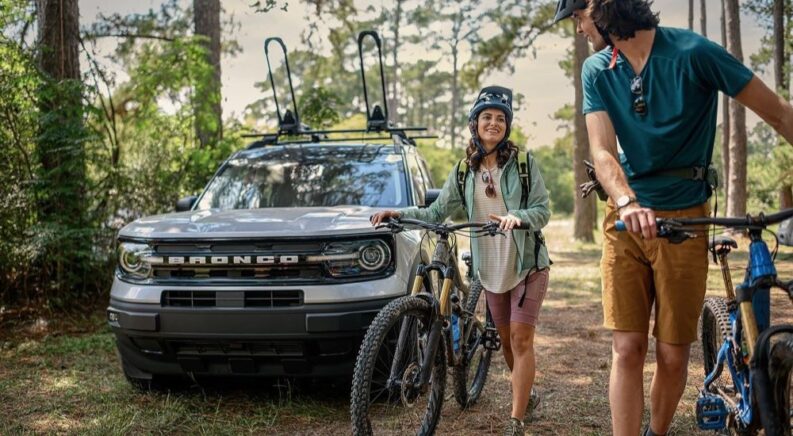When the Bronco made its comeback a few years ago, it was clear that Ford was aiming directly at the Jeep Wrangler and looking to deliver the most capable off-road SUV on the market. If anything was a surprise, however, it was that Ford brought not just one but two options to the (off-) road by offering the standard Bronco and a Ford Bronco Sport for sale. This was an absolute power move by Ford as it established that they were looking to dethrone the Wrangler while simultaneously giving drivers more options than Jeep does; you could argue a Trail Rated smaller model is comparable to the Bronco Sport, but that’s not always the case.
With the smaller and more-affordable Bronco Sport available, the question arises whether both of these models need to exist. The answer is a pretty simple “yes” since some significant differences between them make each one a great option for different sorts of drivers. That being said, the best way to understand what this answer means is to look at the Bronco Sport and the Bronco to see how they compare. For fans of going off-road, Ford has given us an embarrassment of riches and there have never been better options for hitting the trail in an SUV.
Differences in Size by the Numbers
The most obvious difference between these two SUVs, and a great place to start when looking at them and trying to understand what each brings, is their size. Simply put, the Ford Bronco is a midsize SUV that’s available as either a four-door or a two-door model, while the Bronco Sport is a smaller subcompact model that’s only offered with four doors. Both models have two rows of seating inside—while two-door Bronco models have seats for just four people; otherwise, they both fit five passengers quite comfortably. To fully appreciate how different they are in size, it helps to look at both models’ exterior and interior.
With the Bronco, most two-door models are about 173 inches in length and 86 inches wide, while four-door models are typically about 190 inches long and the same width. Interestingly, the Bronco Sport measures about 173 inches in length and about 82 inches wide; you can see that this means the Bronco Sport is nearly the same size as a two-door Bronco. The Bronco Sport actually has more room inside for cargo than two-door Bronco models, with about 30 cu.ft. of rear cargo space and more than 60 cu.ft. of total cargo volume available compared to around 22 cu.ft. of cargo volume in the back of a two-door Bronco and just over 52 cu.ft. of total cargo space available. Four-door models are much larger, with more than 77 cu.ft. of total cargo space available, but it’s interesting to see how spacious the Bronco Sport is inside.
Engines and Performance
Size isn’t everything, of course, and great off-road vehicles need plenty of power to help tackle anything the trail throws at them. This will be one area where the Bronco definitely comes out on top, particularly since it’s a larger midsize SUV and needs that extra power. Still, the Bronco starts with a 2.3L I-4 engine that delivers 300 hp and 325 lb-ft of torque, with an available 2.7L V6 engine that boosts performance up to 330 hp and 415 lb-ft of torque. These are both excellent options for a midsize SUV—we’re not even going to talk about the Bronco Raptor because it’s on another level.
The smaller Ford Bronco Sport comes with a 1.5L I-3 engine that delivers 181 hp and 190 lb-ft of torque, which is great for a subcompact model like this, but it certainly can’t compete with what the standard Bronco comes with. There’s an available 2.0L I-4 that turns out 250 hp and 277 lb-ft of torque that’s a fantastic choice; it still falls short of what the Bronco can do, but it’s a lot closer. Both engines are paired with an eight-speed automatic transmission for solid performance, but the Bronco gets a 10-speed automatic. Even more noteworthy: the standard engine for the Bronco has a seven-speed manual transmission available, but you won’t find a manual on the Bronco Sport.
Off-Road Performance by the Numbers
You might argue that the most important thing about an off-road SUV is how well it holds up on the trail, and I would agree with you. Plenty of midsize SUVs and subcompact crossovers are available on the market; what sets these two apart is that they can get some serious work done on the trail. To start with, let’s look at some of the key specs and numbers for these two SUVs to see how they compare—to keep things simple, these are the best capability numbers for both models:
Ford Bronco
- Ground Clearance: 11.7 inches
- Water Fording: 36.4 inches
- Approach: 43.2 degrees
- Breakover: 29.0 degrees
- Departure: 37.2 degrees
Ford Bronco Sport
- Ground Clearance: 8.8 inches
- Water Fording: 23.6 inches
- Approach: 30.4 degrees
- Breakover: 20.4 degrees
- Departure: 33.1 degrees
We can see that the numbers definitely favor the standard Bronco, as it offers superior capability in every single category. That’s not entirely surprising given its larger size and potential with things like 35-inch tires and the Sasquatch Off-Road package available. Still, it’s important to note these differences and see just how well the midsize Bronco can do on the trail, though the Bronco Sport is certainly no slouch. For me, the Bronco Sport offers all of the capability I would need, though I’m sure some off-road fans looking to tackle the most challenging trails would prefer what the Bronco can do.
Off-Road Features and Options
In terms of off-road functionality, the Bronco Sport has a wide range of impressive features, though some depend on the trim level you look at. The Badlands is a great one to focus on since it comes with the more powerful engine, features an advanced 4×4 with a twin-clutch rear drive unit, and has the Bronco’s Terrain Management System, including G.O.A.T. (Goes Over Any Type of Terrain) Modes. There are seven GOAT Modes for the Badlands trim of the Bronco sport, including Mud/Ruts and Rock Crawl, whereas most other models lack those two and have five modes instead. The Bronco Sport Badlands features Ford Trail Control, has metal bash plates, and Falken Wildpeak All-Terrain Off-Road tires are available.
The larger Bronco also has a Badlands model available with an electronic-locking front and rear axle, an advanced 4×4 system with Automatic On-Demand Engagement, and the Terrain Management System with seven G.O.A.T. Modes. There are full underbody bash plates on the Bronco Badlands, and it has 35-inch Mud-Terrain tires available for excellent off-road capability. Where the Bronco comes out on top, however, is that it has more trims beyond the Badlands that the Bronco Sport lacks, like the Wildtrak. The Bronco Wildtrak features a powerful V6 engine and comes with the Sasquatch Package that includes 35-inch tires, Bilstein Position-Sensitive Dampers, and more to create an incredible off-road experience.
What Does This Mean for the Bronco Sport?
At the end of the day, the Ford Bronco Sport is a fantastic choice for anyone looking for a subcompact crossover model that can handle just about any off-road adventure. The larger Bronco does have some features that push it further, like the Sasquatch Package and superior specs for hitting the trail, but it doesn’t overshadow the smaller model.
My takeaway from looking at both is that Ford has delivered two great off-road SUVs designed to meet the needs of a wide range of drivers. In terms of overall capability, the Bronco comes out on top, but the Bronco Sport holds its own and is the perfect choice for anyone who doesn’t need the extra size of a four-door Bronco. Ultimately, the Bronco Sport compares very favorably, and the real winner is anyone who gets to enjoy either of these vehicles.




